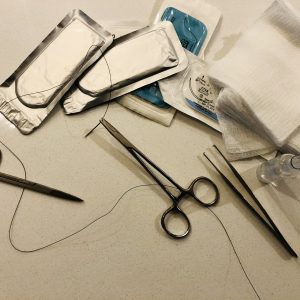Want to experience the greatest in board studying? Check out our interactive question bank podcast- the FIRST of its kind here: emrapidbombs.supercast.com
Author: Josh Chait, MS3
Peer Reviewer: Blake Briggs, MD; Carmen Martinez Martinez, MD
Introduction
The muscle groups of the extremities are contained within an inelastic myofascial compartment. Swelling in a tight muscle compartment from bleeding or edema increases intracompartmental pressures, leading to decreased perfusion in that compartment- this is acute compartment syndrome (ACS).1,2 ACS is rare, but a major complication of soft tissue injury. It is more common in males and those < 35 years old (higher incidence of trauma in this age group).3 Fractures are associated with 75% of ACS, however, ACS not associated with a fracture are at greater risk of delayed diagnosis and treatment.4,5 A swift diagnosis is imperative as delayed treatment leads to long-term consequences and higher mortality. This review will discuss the pathophysiology, presentation, and diagnosis of acute compartment syndrome.
Pathophysiology
The most common cause of ACS is trauma. The most common location for ACS is the anterior tibial compartment of the leg, with tibial fractures being the most common risk factor.1,2,3 The volar (flexor) compartment of the forearm and the foot are also common locations for ACS.5,6 Both open and closed fractures are associated, in fact open fractures might increase the overall risk. ACS is caused by an increase in volume within a fascial compartment (think edema and hemorrhage) or a decrease in volume capacity within a compartment (think tight wound dressing or cast). The increase in pressure within the compartment causes decreased perfusion leading to tissue necrosis, neurologic damage, and possibly amputation.3 Tissue necrosis can begin as quickly as 3 hours and neurologic damage may be irreversible if treatment via fasciotomy is not performed within 12 hours of onset.7,8 Irreversible ischemic complications can result from failure to treat or delayed treatment of compartment syndrome (e.g. Volkmann contracture or foot drop).
There are other traumatic causes of compartment syndrome as well, including bleeding disorders or anticoagulant use, crush injuries, deep burns, penetrating trauma, and high-pressure injection injuries.
Non-traumatic causes include ischemia-reperfusion injury (usually after arterial occlusion), DVTs, envenomation, iatrogenic IV extravasation, and some necrotizing infections.2,9
The key to understanding compartment syndrome is about perfusion pressure.
Compartment perfusion pressure = MAP – compartment pressure
Normal compartment pressure = 0 to 8 mm Hg. A reduction in tissue perfusion leads to a reduction in venous drainage, causing significant tissue edema. A reduction in lymphatic drainage, further increases pressure in the compartment and leads to compression of arterioles. This results in end-organ ischemia.
Presentation
ACS should be on your differential for anyone with extremity trauma, especially those who sustain a fracture. In a high-risk patient, signs and symptoms consistent with progressive swelling and neurovascular change within an extremity over the course of hours should sound the alarm bells. For this reason, serial exams are crucial, evaluating for a tight, painful muscle comparment.3
Accelerate your learning with our EM Question Bank Podcast
- Rapid learning
- Interactive questions and answers
- new episodes every week
- Become a valuable supporter
Symptoms of ACS include intense pain (often described as out of proportion to exam findings), paresthesias, and deep, achy burning pain located in the distribution of a myofascial compartment. On exam, the most common findings include pain with passive movement of muscles in the affected compartment (early sign), a tight “wood-like” feeling on palpation of the affected compartment, diminished sensation, muscle weakness, and eventually paralysis of the affected muscles.4,10 These are the patients who receive appropriate analgesia but still complain of extreme pain to the affected extremity.
Pain out of proportion to exam is the earliest symptom, however, it has poor sensitivity.11 Compartment firmness is the earliest objective sign, seen in ~50% of patients. 4,11 Paresthesias tend to occur < 2 hours after injury and are suggestive of neurologic ischemia. Muscle weakness tends to occur in the 2 to 4 hour window after injury.2
Diagnosis
About 50% lower limbs require amputation when treatment is delayed, 92% will develop neuropathy. Mortality is related to renal failure or sepsis. You get the picture that urgency is necessary in these patients, but for a pathology that requires a “clinical diagnosis”, the exam is only modestly helpful at best.
– A delta “perfusion pressure” <20 mmHg is a definite indication for fasciotomy, <30 mmHg may be a relative indication clinical signs of acute compartment syndrome.
– An “absolute pressure” from one single compartment that is >30 mmHg with a clinical picture consistent with compartment syndrome is diagnostic as well.
Delta pressure = diastolic blood pressure [BP] – measured compartment pressure
The pressure at which a compartment should undergo fasciotomy is still debated. A single compartment pressure measurement has been shown to have low specificity leading to over-diagnosis and over-treatment. Therefore, it should be interpreted in the correct clinical context of the patient.
The first compartment you should be checking is the anterior. The most missed compartment is the deep posterior. It’s hard to measure pressures in this compartment as you must go right between the tibia and fibula.
Unfortunately, perfusion pressure has been shown in studies to generate false-positive results in 18–84% of patients with tibial fractures. Two studies showed that not one patient with measurements qualifying for fasciotomy required it.
In many cases, young children, obtunded, critically ill patients, and those emerging from sedation, cannot participate in a physical exam to look for clinical signs and symptoms of compartment syndrome.
Despite the limitations of the test, experts still advocate its use in the face of diagnostic uncertainty and the high risk of irreversible tissue damage and high morbidity if compartment syndrome is missed. In fact, one survey sent to 264 practicing orthopedic surgeons, 78% regularly used compartment pressure measurements to determine the need for fasciotomy.
The Stryker device is preferred and most frequently used. Still, a modified arterial pressure monitoring system is also an option, along with slit catheters and side-port needles, all with similar findings of intracompartment pressure.
Labs
Labs are not useful in diagnosis and should never be prioritized over starting treatment.
Management
● After the diagnosis is made or suspected, you should immediately consult surgery. The patient needs a fasciotomy performed and direct intracompartmental pressure can be monitored (via needle manometry). Ideally, fasciotomy is done within 4 hours of onset and if compartment pressure is measured to be over 30 mmhg.2,3
● Remove any restrictive casts, bandages, splints, or anything that could increase extrinsic pressure on the affected compartment.2
● Analgesia (ACS hurts!) and supplemental oxygen should be given.
● If hypotensive, give crystalloid boluses as needed as hypotension can further exacerbate decreased perfusion to the affected compartment. If you have a hypotensive trauma patient, make sure to address the cause (e.g. hemorrhage).2
● The limb should be in a neutral position, neither elevated or in a dependent position.18
● Again, the only definitive treatment is fasciotomy.
Summary
Delaying diagnosis has dire consequences and can lead to muscle necrosis, neurologic damage, chronic pain, amputation, and infection.3
Though a thorough exam and history is important for catching and preventing the sequela of less common causes of ACS, a patient with extremity trauma (especially with a fracture) should leave you wary. In a patient who presents with risk factors, pain with passive movement, paresthesias, and pain at rest is associated with a sensitivity of 93% for ACS12. Essentially, any patient with a combination of these symptoms probably has ACS and you need to act fast.
References
1. Schmidt AH. Acute compartment syndrome. Injury. 2017;48 Suppl 1:S22-S25. doi:10.1016/j.injury.2017.04.024
2. Hammerberg ME. Acute Compartment Syndrome of the Extremities. UpToDate [Internet]. 2021. Available from: https://www.uptodate.com/contents/acute-compartment-syndrome-of-the-extremities.
3. Long B, Koyfman A, Gottlieb M. Evaluation and Management of Acute Compartment Syndrome in the Emergency Department. J Emerg Med. 2019;56(4):386-397. doi:10.1016/j.jemermed.2018.12.021
4. Elliott KG, Johnstone AJ. Diagnosing acute compartment syndrome. J Bone Joint Surg Br 2003; 85:625.
5. C.H. Rorabeck, K.M. Clarke. The pathophysiology of the anterior tibial compartment syndrome: an experimental investigation. J Trauma, 18 (1978), pp. 299-304
6. B.S. Kalyani, B.E. Fisher, C.S. Roberts, P.V. Giannoudis. Compartment syndrome of the forearm: a systematic review. J Hand Surg Am, 36 (2011), pp. 535-543
7. Hope MJ, McQueen MM. Acute compartment syndrome in the absence of fracture. J Orthop Trauma 2004; 18:220.
8. C. Vaillancourt, I. Shrier, A. Vandal, et al. Acute compartment syndrome: how long before muscle necrosis occurs? CJEM, 6 (2004), pp. 147-154
9. Chung KC, Yoneda H, Modrall GJ. Pathophysiology, classification, and causes of acute extremity compartment syndrome. UpToDate [Internet]. 2022. Available from: https://www.uptodate.com/contents/pathophysiology-classification-and-causes-of-acute-extremity-compartment-syndrome.
10. Olson SA, Glasgow RR. Acute compartment syndrome in lower extremity musculoskeletal trauma. J Am Acad Orthop Surg. 2005;13(7):436-444. doi:10.5435/00124635-200511000-00003
Ulmer, T. (2002). The clinical diagnosis of compartment syndrome of the lower leg: are clinical findings predictive of the disorder?. Journal of orthopaedic trauma, 16(8), 572-577.
11. Mubarak SJ, Pedowitz RA, Hargens AR. Compartment syndromes. Curr Orthop. 1989;3:36-40.
12. Whitney A et al. Do one-time intracompartmental pressure measurements have a high false-positive rate in diagnosing compartment syndrome. Acute Care Surg 2014; 76: 479-83.
13. Nelson JA. Compartment pressure measurements have poor specificity for compartment syndrome in the traumatized limb. J Emerg Med. 2013 May;44(5):1039-44.
14. Tiwari A, Myint F, Hamilton G. Compartment syndrome. Eur J Vasc Endovasc Surg 2002; 24:469.
15. Kosir R, Moore FA, Selby JH, et al. Acute lower extremity compartment syndrome (ALECS) screening protocol in critically ill trauma patients. J Trauma 2007; 63:268.
16. Wall CJ, Richardson MD, Lowe AJ, et al. Survey of management of acute, traumatic compartment syndrome of the leg in Australia. ANZ J Surg 2007; 77:733.
17. Hammerberg EM, Whitesides TE Jr, Seiler JG 3rd. The reliability of measurement of tissue pressure in compartment syndrome. J Orthop Trauma 2012; 26:24.
18. Valdez C, Schroeder E, Amdur R, Pascual J, Sarani B. Serum creatine kinase levels are associated with extremity compartment syndrome. J Trauma Acute Care Surg. 2013 Feb;74(2):441-5; discussion 445-7.



